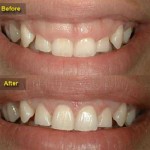 Crown lengthening is a dental procedure which involves the removal of gum tissue, bone or both to expose a greater height of your tooth structure. It is normally done by a periodontist to increase a restoration’s retention or to improve the esthetics of your gums. Crown lengthening can be done on one tooth, or to several teeth and the total surgery time will depend upon how many teeth are involved.
Crown lengthening is a dental procedure which involves the removal of gum tissue, bone or both to expose a greater height of your tooth structure. It is normally done by a periodontist to increase a restoration’s retention or to improve the esthetics of your gums. Crown lengthening can be done on one tooth, or to several teeth and the total surgery time will depend upon how many teeth are involved.
Here are some common indications for crown lengthening:
(1)Â Â Â Restorative purposes
-Â Â Â Â Â Â Â Â Â Crown lengthening is done so that your dentist can access and restore any subgingival caries (caries which develop below your gum line)
-Â Â Â Â Â Â Â Â Â To increase your clinical crown height lost due to caries, fracture or tooth wear. A minimum amount of sound tooth structure is required to ensure the mechanical resistance and retention of your fixed restorations (crowns, bridges,etc)
(2)Â Â Â Aesthetics purposes
Improve esthetics when there is:
-Â Â Â Â Â Â Â Â Â Short teeth /teeth which are worn down due to old age, bruxism
-Â Â Â Â Â Â Â Â Â Unesthetic gingival contours.
-Â Â Â Â Â Â Â Â Â When you have gummy smile(excessive showing of gums)
Â
Contraindications for surgical crown lengthening:
-Â Â Â Â Â Â Â Â Â Teeth that are non restorable (poor prognosis)
-Â Â Â Â Â Â Â Â Â Teeth with long clinical crowns. Crown lengthening surgery can create an unesthetic outcome.
-Â Â Â Â Â Â Â Â Â Patients who smoke/with poor oral hygiene.
What are the disadvantages of crown lengthening surgery?
-Â Â Â Â Â Â Â Â Â You may be uncomfortable during the surgery and it may take around 3 months for the new gingival contour to reestablish and stabilize.
-Â Â Â Â Â Â Â Â Â Exposure of dentine during crown lengthening surgery may result in post operative sensitivity.
Before the surgery,the dental practitioner will:
1.      Perform examination and diagnostic procedures such as periodontal probing depths (placing a probe to check for any periodontal pockets) and taking radiographs to determine the state of health of your periodontal tissues.
2.      Work with the restorative specialist to achieve the ideal crown height.
3.      Take an impression and show you the diagnostic wax up. (diagnostic wax up allows you to visualize the result of surgery)
4.     Scaling and root planing is done prior treatment to ensure healthy periodontal condition.
5.      Explain the details of crown lengthening surgical procedure.
Â
Crown lengthening procedure:
Crown lengthening will be carried out under local anesthesia. Hence, there should be minimal discomfort during the surgical procedure.
- 1.      Incisions will be placed on your gums and once a flap is raised, a small amount of bone and gum tissue will be removed from the tooth.
- 2.      After a certain amount of tooth structure is exposed, the specialist will wash the site with sterile saline and sutures will be placed to stitch the gums together.
- 3.      Pain killers and anti inflammatory drugs are usually prescribed in order to reduce any post operative pain.
- 4.      The entire healing process will take around three months before any fixed restorations can be placed.
      Post operative instructions that you should follow after the crown lengthening surgery
1.      You should avoid : (i)  eating or drinking for one hour.
(ii) taking hot drinks for the 1st day
(iii) smoking during the healing process
(iv) touching/playing the surgical site with your tongue.
2.      You should take any pain killers if there is pain when the anaesthetic wears off.
3.      You should rinse your mouth with warm salt water or 0.2% Chlorhexidine mouthwash for its antibacterial action. You should reduce or avoid intake of coffee, tea, and smoking when using a chlorhexidine mouthwash as it can cause staining.
4.      Use a soft toothbrush and brush on the non surgical area. (Maintenance of good oral hygiene is important during the healing period)
5.      You should inform the dental specialist if you are having any extensive pain, swelling or bleeding.
Â
Â
Â